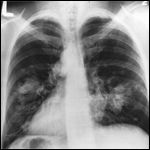Lung Cancer Deaths Not Reduced by Chest X-Ray Screening
A trial of 154,901 participants between the ages of 55 and 74 sought to address whether chest radiographs as lung cancer screenings affect lung cancer incidence and mortality rates from lung cancer.
A trial of 154,901 participants between the ages of 55 and 74 sought to address whether performing chest radiographs affects lung cancer incidence and mortality rates from lung cancer. The trial, which randomized people one to one either to annual screening or usual care for four years, found that chest x-rays did not reduce lung cancer mortality.

Both sides of the lungs are visible with a growth on the left side of the lung, which could be lung cancer.
The intervention group was offered annual posteroanterior-view chest radiographs while usual-care patients were not offered interventions. The study is published today, online in the November 2 issue of JAMA (doi:10.1001/jama.2011.1591) and will be presented at the annual meeting of the American College of Chest Physicians (CHEST 2011). The results are part of the Prostate, Lung, Colorectal, and Ovarian (PLCO) Cancer Randomized Trial.
Martin M. Oken, MD of the University of Minnesota and Philip C. Prorok, PhD of the Division of Cancer Prevention at the NCI and colleagues analyzed participants at one of ten screening centers in the United States between 1993 and 2001. The demographics of the two groups were similar: half were women, about 45% had never smoked, 42% were former smokers, and 10% were current smokers. A total of 1,213 lung cancer deaths were observed in the x-ray screened group compared to 1230 in the usual care group over a 13-year follow up period. In total, 1,696 lung cancers were detected in the screened group and 1620 were detected in the usual care group. It was not possible to accurately detect overdiagnosis rates.
The authors conclude that "these findings provide good evidence that there is not a substantial lung cancer mortality benefit from lung cancer screening with four annual chest radiographs." The Mayo Lung Project trial of chest radiograph and sputum cytology screenings completed in the early 1980s also did not show a mortality benefit.
In an accompanying editorial, Harold C. Sox, MD at Dartmouth Medical School highlights that this is one of two complementary lung cancer screening trial results released in the last two months The second is the National Lung Screening Study (NSLT), which found that annual low-dose computed tomography reduced lung cancer mortality by 20% relative to annual chest radiography ("NCI-Funded Study Finds Low-Dose CT Scans Better than X-Rays in Reducing Lung Cancer Mortality," July 21, 2011, CancerNetwork).
Sox comments that the "PLCO lung cancer study provides convincing evidence that lung cancer screening with chest radiography is not effective." He highlights that this study is important for putting the question of whether chest radiography is beneficial for decreasing the rate of mortality from lung cancer. According to Sox, "the NLST showed convincingly that early detection can lower the risk of death from lung cancer, a big step forward." Now, he suggests that a real-world comparison between usual care and low-dose CT is warranted.